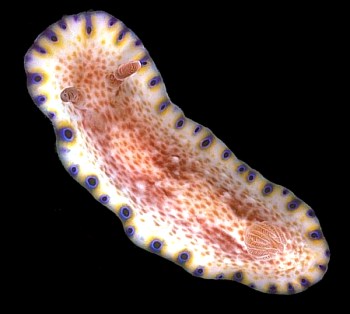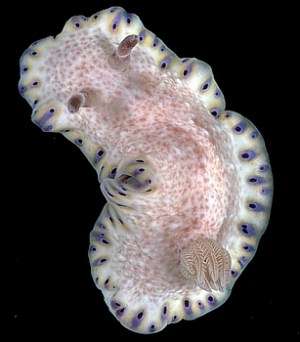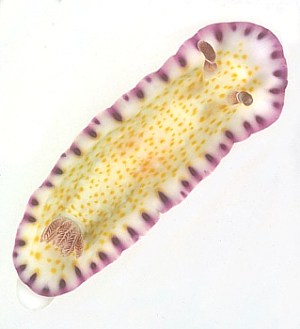
Chromodoris aureopurpurea
Collingwood, 1881
Order: NUDIBRANCHIA
Suborder: DORIDINA
Superfamily: EUDORIDOIDEA
Family: Chromodorididae
DISTRIBUTION
Tropical West Pacific.
PHOTO
UPPER RIGHT: nr Îlot Maître, Nouméa, New Caledonia, October 1988. 30mm long alive. PHOTO: Bill Rudman.
LOWER RIGHT: La Perouse, Botany Bay, Sydney, New South Wales, 10m, January 1977, 22mm long preserved. PHOTO: J.Fields.
LOWER LEFT: Koumac, New Caledonia, October 1993, 25mm long alive. PHOTO: Bill Rudman.
Note added 7 March 2005: see message #13260 suggesting this species may be synonymous with C. alius, C. albopustulosa , and C. rufomaculata , which would give it a wide Indo-West Pacific distribution.
Chromodoris aureopurpurea grows to about 40mm long. The mantle is white and there are yellow to dull brown irregular spots all over the central region. Right at the edge of the mantle is a band of diffuse watery purple and on its inside edge is a submarginal band of large deep purple spots. In all specimens seen from Australia, there is a yellow spot or crescent on the inside edge of each purple spot. There is usually an unspotted zone, quite wide anteriorly, separating the submarginal purple spots from the central region of the mantle spotted with yellow or brown.
The rhinophore clubs are heavily pigmented with purple or reddish brown and edged in white. The gills are translucent purple or red-brown, and also edged with white. The underside of the mantle, the sides of the body, and the foot are white except for the edge of the mantle which can be deep purple. There is some colour variation, with the dorsal spots ranging in colour from yellow to dull brown, and in size, from quite large blotches to small spots.
Chromodoris aureopurpurea was originally described from the coast of China as having a mantle covered with "small irregular blotches of bright yellow of a roundish or elliptical form. Mantle edged with faint violet and an irregular row of deep violet-shaded spots running all round upon the faint edging". Also the rhinophores and gills are of a dark colouration and edged in white. Specimens from Japan and China lack the yellow crescent or mark on the inside edge of each purple spot, which is found in specimens from Australia and New Caledonia. The faint violet marginal band and submarginal band of purple spots distinguish this species from Chromodoris rufomaculata and Chromodoris alius, in which the purple spots are right at the edge. Another similar species from the western Pacific is Chromodoris collingwoodi, and from the Indian Ocean, C. tennentana.
Reference:
•Rudman, W.B. (1987) The Chromodorididae (Opisthobranchia: Mollusca) of the Indo-West Pacific: Chromodoris epicuria, C. aureopurpurea, C. annulata, C. coi and Risbecia tryoni colour groups. Zoological Journal of the Linnean Society, 90: 305-407.


Rudman, W.B., 1999 (November 8) Chromodoris aureopurpurea Collingwood, 1881. [In] Sea Slug Forum. Australian Museum, Sydney. Available from http://www.seaslugforum.net/factsheet/chroaure
Related messages
-
Feeding record for Chromodoris aureopurpurea from Port Stephens
From: Leanne and David Atkinson, March 24, 2010 -
Chromodoris aureopurpurea from sthn Queensland
From: Bruce Wilkie, January 17, 2007 -
Chromodoris aureopurpurea from INdonesia
From: Erwin Kodiat, January 20, 2006 -
Chromodoris aureopurpurea from South Korea
From: Dong Bum Koh, September 6, 2005 -
Chromodoris aureopurpurea - egg-laying
From: Leanne & David Atkinson, March 13, 2003 -
Chromodoris aureopurpurea from Lembeh Strait
From: Mary Jane Adams , December 14, 2002 -
Chromodoris aureopurpurea from New South Wales
From: Allan Saben, November 25, 2002 -
Nudibranch from Oak Park, Sydney
From: Janet Hall, November 14, 2002 -
Chromodoris ? from Indonesia
From: Alice Lee, June 17, 2002 -
Chromodoris aureopurpurea from New South Wales
From: Ákos Lumnitzer, April 22, 2002 -
Chromodoris aureopurpurea from Japan
From: Jun Imamoto, September 1, 2001 -
Chromodoris aureopurpurea from Hong Kong
From: Leslie Chan, July 12, 2001 -
Chromodoris aureopurpurea? from Papua New Guinea
From: M.J. Adams, August 15, 2000 -
What is this one?
From: Des Paroz, August 13, 2000
